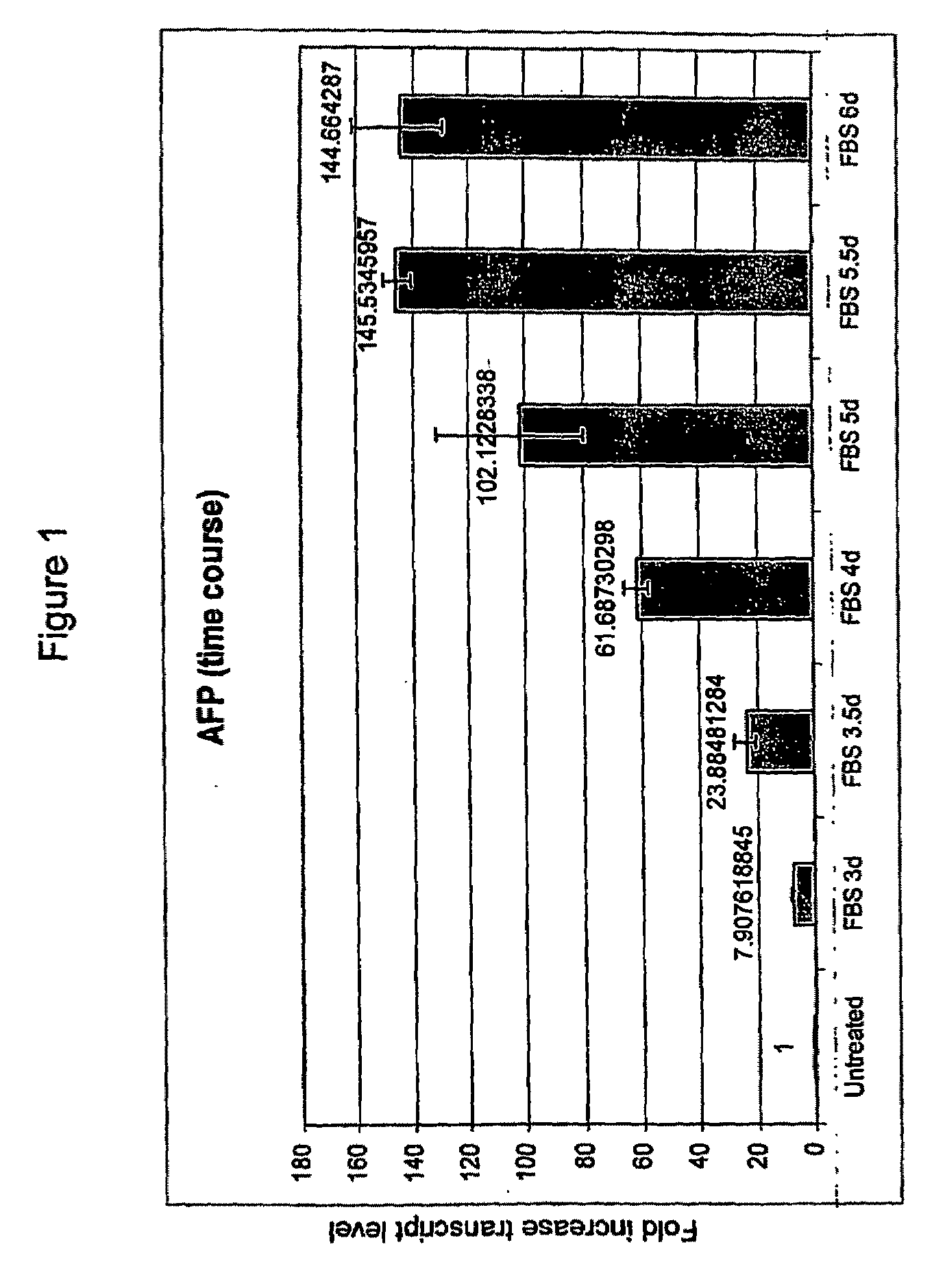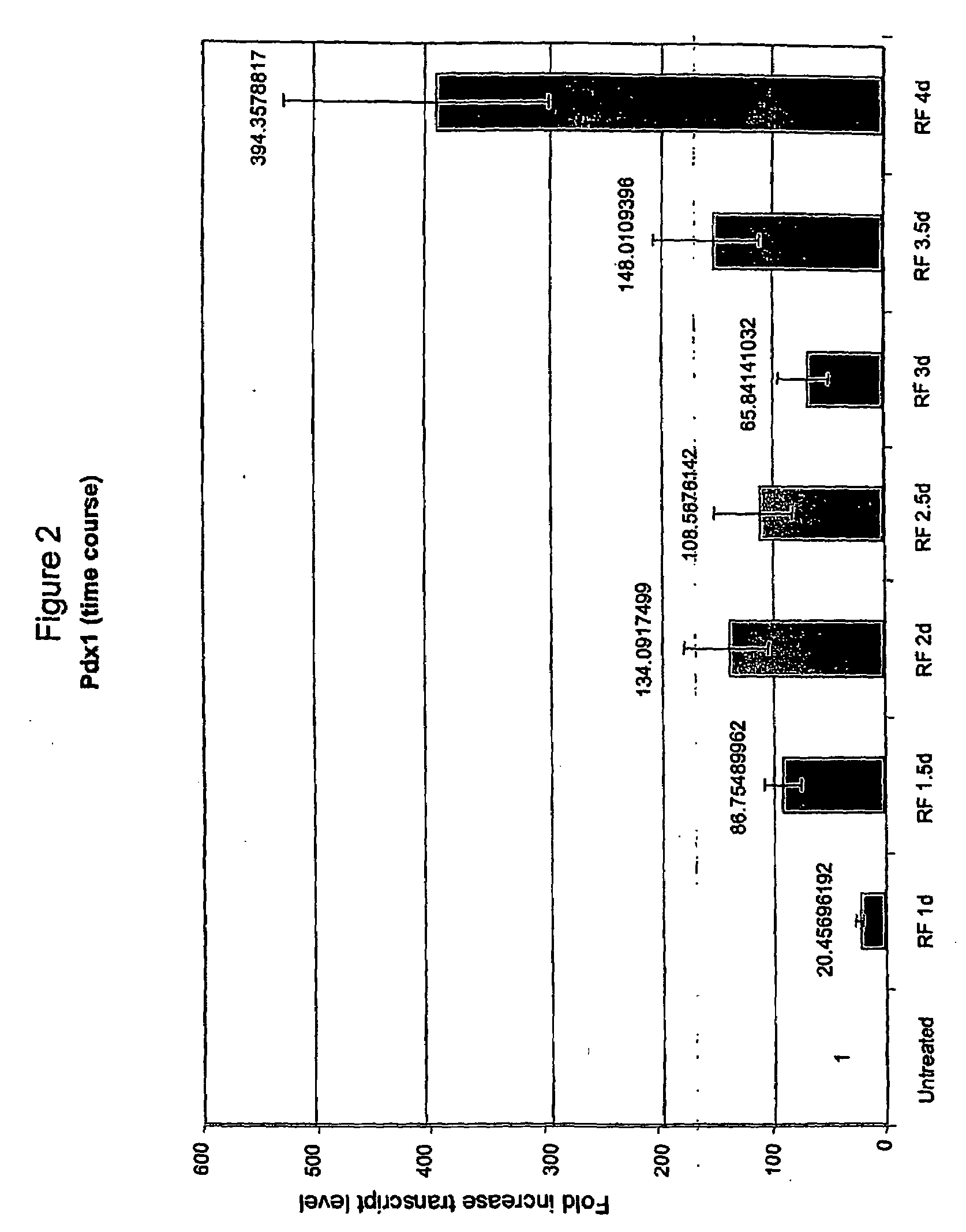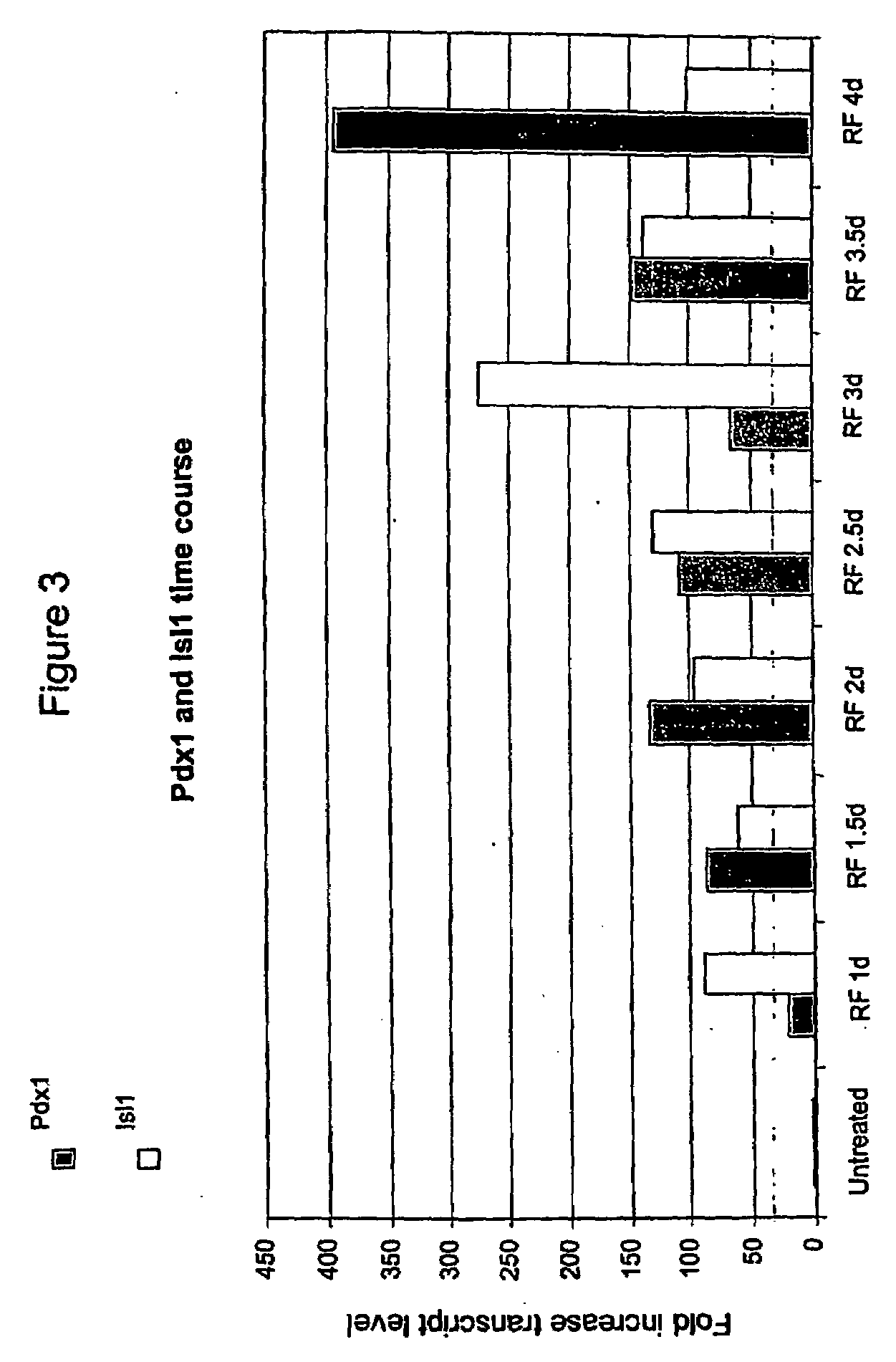Pancreatic and Liver Endoderm Cells and Tissue by Differentiation of Definitive Endoderm Cells Obtained from Human Embryonic Stems
a technology of endoderm cells and liver, which is applied in the field of pancreatic and liver endoderm cells and tissue by differentiation of definitive endoderm cells obtained from human embryonic stems, can solve the problems of difficult to tightly control differentiation or form homogeneous populations of partially or terminally differentiated cells by pluripotent cell differentiation in vitro, and the inability to achieve the differentiation of definitive endoderm cells in vitro, and achieves the effect of promoting differentiation and promoting pi3
- Summary
- Abstract
- Description
- Claims
- Application Information
AI Technical Summary
Benefits of technology
Problems solved by technology
Method used
Image
Examples
example 1
Culture of Human ES Cells
Routine Human ES Cell Culture
[0117]The human embryonic stem cell line BG01 (BresaGen, Inc., Athens, Ga.) may be used in this work. BG01 cells are grown in hES Medium, consisting of DMEM / F-12 (50 / 50) supplemented with 20% knockout serum replacer (KSR; Invitrogen), 0.1 mM MEM Non-essential amino acids (NEAA; Invitrogen), 2 mM L-Glutamine (Invitrogen), 50 U / ml penicillin, 50 μg / ml streptomycin (Invitrogen), 4 ng / ml bFGF (Sigma) and 0.1 mM β-mercaptoethanol (Sigma). The cells are grown on mouse primary embryonic fibroblast feeder layers that were mitotically inactivated with mitomycin C. Feeder cells are plated at 1.2×106 cells per 35 mm dish. The BG01 cells are passaged using a collagenase / trypsin method. Briefly, medium is removed from the dish, 1 ml of 200 U / ml Collagenase type IV (GibcoBRL) is added, and the cells are incubated at 37° C. for 1-2 minutes. Collagenase is removed and 1 ml of 0.05% trypsin / 0.53 mM EDTA (GIBCO) is applied. Cells are incubated at ...
example 2
Treatment of HES Cells with Inhibitors of PI3-Kinase Leads to Differentiation of the HES Cells
Inhibitor / Differentiation Agent Treatment of Stem Cells
[0120]BG01 cells are passaged from feeders using the collagenase / trypsin method and are plated on matrigel coated dishes at 1×105 cells / 35 mm dish in conditioned medium (CM; MEF conditioned medium plus 8 ng / ml bFGF). After approximately 24 hours, the media is replaced with fresh CM, CM with inhibitor (resuspended in EtOH), CM with EtOH, or with Spontaneous Differentiation medium (hES medium minus bFGF).
[0121]In alternative methods, the BG01 cells may be plated at different concentrations prior to contact with CM, CM with inhibitor and CM with EtOH Cells may be plated at the following concentrations: approximately 5×104 cells / 35 mm dish, approximately 1×105 cells / 35 mm dish, approximately 2×105 cells / 35 mm dish, approximately 4×105 cells / 35 mm dish and, approximately 6×105 cells / 35 mm dish.
[0122]The inhibitor LY 294002 (Biomol) may be pr...
example 3
Characteristics of Cells Treated with Inhibitors of PI3-Kinase
[0126]The inhibitor studies are performed as described in Example 2.
[0127]For flow cytometry, the BG01 cells are washed with 1×PBS and fixed in 2% paraformaldehyde / 1×PBS for 10 minutes at room temperature. The cells are then washed in 1×PBS and approximately 2×105 cells are incubated with primary antibody diluted in 1% BSA / 1×PBS. The primary antibodies used are anti-CD9 and anti-thrombomodulin (Cymbus Biotechnology), FITC conjugated mouse monoclonal antibodies at a 1:10 dilution. Cells are incubated at 4° C. for 30 minutes and then washed twice in 1×PBS. Where appropriate, cells are resuspended in a secondary antibody, anti-mouse Alexa-488 (Molecular Probes) diluted 1:1000 in 1% BSA / PBS, incubated at 4° C. for 30 minutes, and then washed twice in 1×PBS. Cells are resuspended in 1% BSA / 1×PBS and surface expression is analyzed using a Beckman Coulter FC500.
RNA Isolation and RT-PCR Analysis
[0128]Total RNA is is...
PUM
| Property | Measurement | Unit |
|---|---|---|
| concentration | aaaaa | aaaaa |
| concentration | aaaaa | aaaaa |
| concentration | aaaaa | aaaaa |
Abstract
Description
Claims
Application Information
 Login to View More
Login to View More - R&D
- Intellectual Property
- Life Sciences
- Materials
- Tech Scout
- Unparalleled Data Quality
- Higher Quality Content
- 60% Fewer Hallucinations
Browse by: Latest US Patents, China's latest patents, Technical Efficacy Thesaurus, Application Domain, Technology Topic, Popular Technical Reports.
© 2025 PatSnap. All rights reserved.Legal|Privacy policy|Modern Slavery Act Transparency Statement|Sitemap|About US| Contact US: help@patsnap.com



